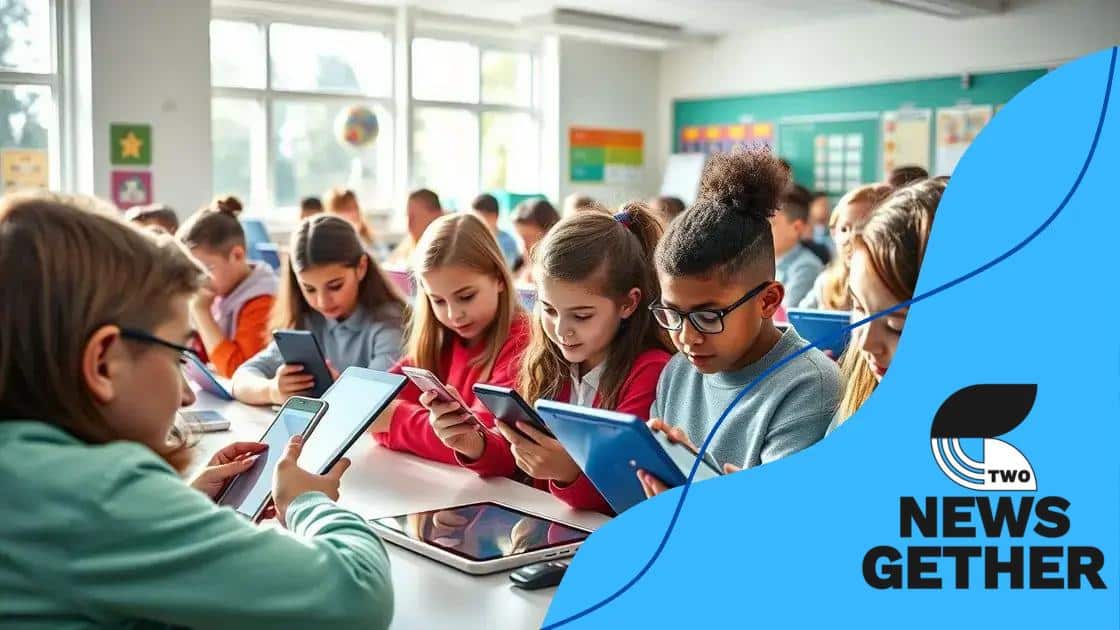Trends in mobile learning and its impact on K-12 education

Trends in mobile learning significantly impact K-12 education by enhancing student engagement, providing personalized learning experiences, and utilizing technologies like AR and VR while addressing challenges related to accessibility and teacher training.
Trends in mobile learning are making a significant impact on K-12 education, transforming how students learn and interact in the classroom. Have you noticed how much technology has influenced our educational landscape recently?
The evolution of mobile learning in K-12 education
The evolution of mobile learning in K-12 education has been remarkable and continues to shape how students interact with their studies. Over the years, technology has merged with education, leading to innovative approaches that keep students engaged.
The Early Days of Mobile Learning
In the beginning, mobile learning was limited to basic devices like cell phones and early tablets. As technology progressed, so did the capabilities of these devices. Teachers began experimenting with educational apps, making lessons interactive.
Transformation Through Apps and Tools
Today, mobile learning is greatly enhanced by various applications designed for educational purposes. Some popular tools include:
- Interactive quizzes and assessments
- Virtual classrooms that facilitate remote learning
- Collaborative tools for group projects
- Access to a vast array of online resources and e-books
This transformation has made learning more accessible, allowing students to study at their own pace from anywhere.
Integration in Classrooms
With the advent of mobile technology, many schools have integrated devices into their curricula. Students now use tablets and smartphones to access materials, conduct research, and collaborate with peers. This shift encourages active learning and helps develop vital skills needed in today’s workforce.
Challenges in Mobile Learning
While the advantages are significant, there are also challenges. Not every student has equal access to mobile devices, which can create disparities in learning opportunities. Additionally, teachers must adapt to new technology and integrate it into their teaching methods effectively.
Despite these hurdles, the evolution of mobile learning continues to inspire improvements in K-12 education. As technology advances, so will the tools available for students and educators.
How mobile devices enhance student engagement
Mobile devices play a crucial role in enhancing student engagement in today’s classrooms. With the rise of technology, students are more connected and empowered to take charge of their learning.
Interactive Learning Experiences
Characteristics of mobile devices allow for interactive learning experiences. Students can participate in live quizzes and polls during lessons. This involvement creates excitement and encourages participation.
Access to Resources
Another way mobile devices enhance engagement is through quick access to a wealth of resources. Students can easily find videos, articles, and e-books online that relate to their subjects. This immediate access helps them learn better and stay interested.
- Educational apps make complex topics easier to understand.
- Videos provide visual aids that capture attention.
- Games and simulations create a fun learning environment.
This ongoing connection with information keeps students curious and eager to learn more.
Collaboration and Communication
Mobile devices also encourage collaboration among students. They can work on projects together, share ideas, and communicate easily through messaging apps or collaboration platforms. This fosters a sense of teamwork and belonging, which are important for a positive learning environment.
Overall, when students use mobile devices, they feel more involved and motivated. The combination of interactive tools, access to resources, and opportunities for collaboration creates an enriching educational experience.
Challenges faced in implementing mobile learning

Implementing mobile learning in K-12 education comes with several challenges. While the benefits are clear, schools and educators must navigate various obstacles to ensure effective integration.
Access and Equity Issues
One major challenge is ensuring that all students have equal access to mobile devices and the internet. Not every student can afford a smartphone or tablet. This issue can lead to disparities in learning opportunities. Schools need to find ways to provide devices for students who lack them.
Teacher Training and Support
Many teachers may not be familiar with mobile learning tools and techniques. Proper training is essential for educators to feel confident in using these tools. Ongoing support is also necessary to help teachers adapt their teaching methods effectively.
Some of the specific needs for support include:
- Workshops on utilizing educational apps.
- Access to resources for lesson planning.
- Assistance with troubleshooting technical issues.
Without adequate training, teachers may struggle to integrate technology into their lessons, which can hinder student engagement.
Curriculum Integration
Integrating mobile learning into existing curricula can be complicated. Teachers need guidance on how to align mobile tools with educational standards. They must ensure that mobile learning supplements rather than replaces traditional teaching methods.
Additionally, constant updates to educational technology mean that curriculum must be flexible. This flexibility is crucial to adapt to new tools and platforms as they emerge.
Despite these challenges, it’s important for schools to persevere. By addressing access issues, investing in teacher training, and focusing on curriculum integration, mobile learning can transform the educational landscape.
Best practices for educators using mobile learning
Using mobile learning effectively requires educators to implement best practices that enhance student learning while navigating technology challenges. These strategies can help teachers maximize the benefits of mobile tools in the classroom.
Focus on Clear Learning Objectives
It’s important for teachers to establish clear learning objectives when integrating mobile learning into their lessons. By defining what students should achieve, educators can choose appropriate apps and tools that align with those goals.
Encourage Active Participation
Mobile learning should foster active participation among students. Teachers can engage their students by using interactive features such as polls, quizzes, and collaborative projects. These activities not only increase involvement but also make learning enjoyable.
Some effective ways to encourage participation include:
- Incorporating educational games into lessons.
- Using discussion boards for class topics.
- Encouraging group work using shared documents.
When students actively participate, they are more likely to retain information and develop critical thinking skills.
Provide Ongoing Feedback
Feedback is an essential component of the learning process. Teachers should use mobile platforms to provide timely and constructive feedback to students. This approach helps students understand their progress and areas for improvement.
Teachers can use various tools such as:
- Online gradebooks for tracking progress.
- Apps for giving instant feedback on assignments.
- Commenting features on collaborative documents.
Ongoing feedback keeps students motivated and focused on their learning paths.
Integrate with Traditional Teaching Methods
While mobile learning presents many opportunities, it should complement traditional teaching methods rather than replace them. For example, a blended approach that combines direct instruction with mobile technology can enhance learning outcomes. This strategy allows students to explore topics in depth while benefiting from direct teacher guidance.
By following these best practices, educators can create a more engaging and effective learning environment that harnesses the power of mobile technology in the classroom.
Future outlook for mobile learning in schools
The future outlook for mobile learning in schools is promising and full of potential. As technology continues to advance, educational practices will evolve, creating more engaging opportunities for students.
Integration of Advanced Technologies
Emerging technologies such as augmented reality (AR) and virtual reality (VR) are set to play significant roles in enhancing mobile learning. These tools provide immersive experiences that can deepen understanding of complex subjects. Imagine students exploring ancient civilizations through VR or visualizing scientific concepts with AR overlays.
Increased Personalization
Mobile learning will also move toward greater personalization. Future educational programs can analyze student data to tailor lessons to individual needs. This personalized approach helps address diverse learning styles, ensuring that every student can grasp concepts effectively.
As a result, students will enjoy:
- Customized learning paths suited to their abilities.
- Enhanced engagement through interests-driven content.
- Focused feedback that aids improvement.
Accessibility Beyond the Classroom
Another key aspect will be the accessibility that mobile learning provides. Students will be able to access educational resources from anywhere, extending learning opportunities beyond the classroom. This flexibility is crucial for students who may need to work at their own pace or have varied schedules.
Furthermore, as schools collaborate with technology companies, they can develop more affordable devices and applications, bridging the gap between different socioeconomic backgrounds. Such advancements will promote equity in education.
Focus on Social and Emotional Learning
The future of mobile learning will also include a focus on social and emotional learning (SEL). Educators will utilize mobile tools to help students build important skills, such as empathy and teamwork. Digital platforms can facilitate virtual discussions and collaborative projects that encourage relationship-building among peers.
With these developments, mobile learning is set to revolutionize the educational landscape. As schools embrace new technologies and teaching methods, they will provide richer and more meaningful learning experiences for all students.
In conclusion, the future of mobile learning in schools looks bright and full of possibilities. With advancements in technology like augmented reality and virtual reality, students will experience engaging and immersive lessons. Personalization will become more prominent, allowing tailored learning experiences that meet individual needs. Accessibility will extend beyond the classroom, ensuring that all students have opportunities to learn at their own pace. Moreover, incorporating social and emotional learning will help students develop essential life skills. As we move forward, embracing these changes will lead to a more enriching educational environment for every student.
\n
\n
FAQ – Frequently Asked Questions about Mobile Learning in Schools
What are the main benefits of mobile learning?
Mobile learning enhances student engagement, provides access to resources anytime, and allows personalized learning experiences.
How can teachers effectively implement mobile learning?
Teachers can focus on clear learning objectives, encourage active participation, and provide ongoing feedback to help students succeed.
What challenges might schools face in adopting mobile learning?
Schools may encounter issues related to access and equity, as well as the need for teacher training and effective curriculum integration.
What is the future of mobile learning in education?
The future includes advancements in technology like AR and VR, increased personalization, and a greater focus on social and emotional learning.






